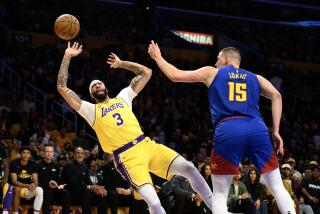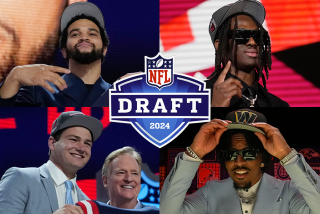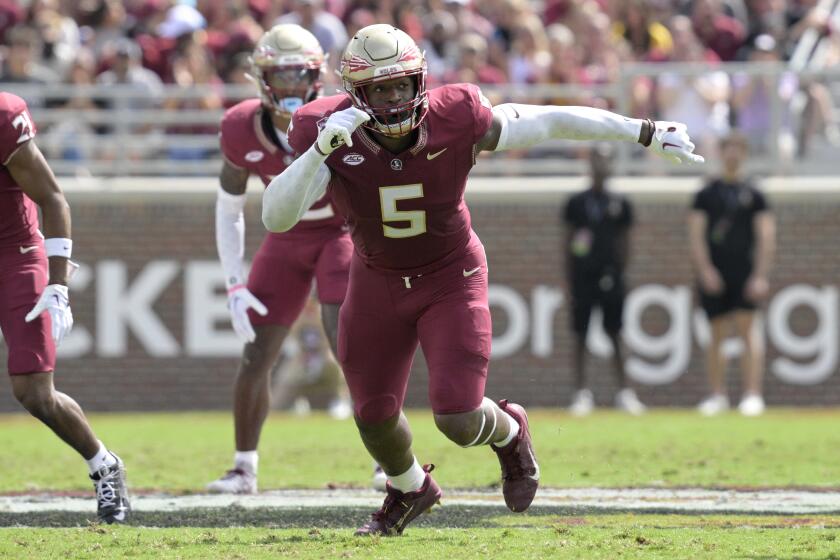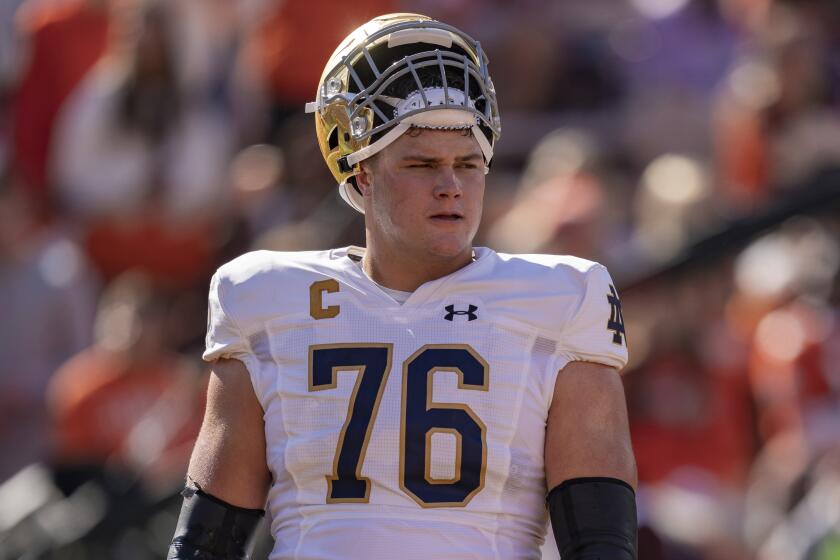Big Ben a Big Timer
The world is suddenly full of great quarterbacks — or, maybe, these folks are merely very good. Anyhow, they’re all over the country. At least two of them are still in school, Aaron Rodgers of Cal and Matt Leinart of USC. And at least two other young ones played like old pros again Sunday: Ben Roethlisberger of the Pittsburgh Steelers and David Carr of the Houston Texans.
At 6 feet 5 and 242 pounds, Big Ben Roethlisberger, who looks even bigger, is an unbeaten rookie from Miami (Ohio) whose next test, in Dallas Sunday against tricky coach Bill Parcells, will be his toughest yet. Moving with the agility of a 200-pound quarterback, the rookie only had to close out Cleveland to win his third straight, 34-23.
In his last two starts, Roethlisberger has beaten the AFC North’s two Ohio teams back to back.
That made the 4-1 Steelers first in the AFC North, surprising even their veteran coach, Bill Cowher.
In his Pittsburgh career going back to 1992, Cowher, a 126-85 winner, has rarely been a fast starter. Nor has he won any Super Bowls. Principally, all this time, he’s been looking for a quarterback. For as one of the league’s fine defensive coaches, Cowher always has a running game, and in recent years he has also embraced passing as the way to go. But he’s never had a champion passer. This year, finally, he might be grooming one.
The One-Dimensional Vikings Roll On
THE MINNESOTA VIKINGS, on their three-game October tour of the South, will be in New Orleans Sunday to show the Saints how to be a commanding winner in the NFL after losing all your veteran running backs to injury. You simply throw the ball on two of every three plays, as the Vikings did last Sunday to finally beat back Houston’s young quarterback Carr in overtime, 34-28.
Altogether, as the one-dimension Vikings struck for more than 500 yards in Houston, quarterback Daunte Culpepper gained 418 yards on passes and scrambles by comparison with the 92 net produced by the Minnesota running game.
Carr, starting his third year at Houston out of Fresno State, showed the passing and running skills of the good NFL veterans — particularly the toughness to get up from sacks and throw strikes — even though, in the fifth quarter, the veteran Culpepper was too much for him
According to an NFL rule of thumb, it takes a well-balanced, two-dimensional team to succeed, and it’s true that running teams lacking a passing game have in recent years had serious troubles (the Miami Dolphins come first to mind.) Yet the rule of thumb has never been challenged by a good one-dimension passing team, and that’s what Minnesota is with Culpepper and two of the NFL’s great wide receivers, Randy Moss and Marcus Robinson. To win, Minnesota scored five touchdowns — all on pass plays. In football, a one-dimension passing team can succeed even though a one-dimension running team can’t.
Turnovers Overrated to Coaches Who Understand Football
THE ST. LOUIS RAMS had lost the first half in Seattle, 24-7, as quarterback Marc Bulger threw two interceptions and was sacked twice. And at halftime, in bars and during gabfests all over the land, the old-timers who don’t like the Rams’ pass-minded coach, Mike Martz, were pounding the table and sarcastically shouting: “Keep passing, Mike. Keep passing! Keep passing!”
That was last Sunday, and it drew a big laugh from everyone. Martz, though, didn’t hear it, and anyhow he doesn’t often take advice. In the last five minutes of the game, he simply kept passing to catch the Seahawks — who in the fourth quarter had stepped out to a 27-10 lead — and in overtime he kept passing to win, 33-27.
Here’s the point: An interception or a sack is nothing but a nuisance to a passing team — along with dropped passes and other bothersome problems like offside penalties in noisy visiting stadiums where unsporting homers try to upset the visitors’ offense. Turnovers are, in fact, inevitable for teams that throw numerous passes. Inevitable but not disruptive. To a passing team, a turnover merely annoys, it doesn’t destroy. A passing team simply absorbs the shock of a turnover and keeps passing to overcome the turnover.
As I’ve said for years, turnovers are overrated. Of all the adverse things that happen to good football teams, turnovers are the most overrated. Fear of turnovers is a relic of the days when Martz’s old critics were active young men playing the football of their era — running-game, field-position football — and trying their mightiest to make no mistakes. That was admirable, then, perhaps, although to focus heavily on the avoidance of mistakes is to miss a lot of touchdowns and a lot of fun.
Then and now, turnovers have been disastrous to teams playing running-game, field-position football — which was Chuck Noll’s football in the years when Terry Bradshaw was his quarterback and the Steelers were winning Super Bowls with probably the best talent ever banded together.
In today’s passing game, field position is itself greatly overrated. Every NFL week, passers move their teams up and down the field at will, as, most recently, Tennessee moved Monday night. You’re stuck on your own 10-yard line? No problem. Just throw the ball.
Note to Martz Critics: He Did Try to Run
THE RAMS made two unacceptable mistakes at Seattle. First, coach Martz demonstrated that at times, between games, he does listen to his critics, both the sarcastic ones and the sincere, all of whom tell him repeatedly that he should start running the ball. Second, perhaps trying to heed his critics in the first half at Seattle, he ran it with running backs Marshall Faulk and rookie Steven Jackson — two of the NFL’s best — at all the wrong times.
The case example of the wrong time to run in a pro game is first down. Defensive teams all concentrate on running plays on first down. Even if they suspect that a pass might be coming, they realize they must be ready for a running play too. They know that offensive coaches all fret that a first-down incomplete will bring up second and long, football’s thorniest offensive down. As an example of the right time to run, think of any time when the defense is anticipating pass — say on second and 8, maybe, or third and 10.
Despite the likelihood that Martz knew better than to send Faulk running on first down four times at Seattle, he did just that. All four runs failed, two in the first quarter, when, consequently, Martz’s offense predictably went three and out. Indeed, up to the time when Seattle led in the second quarter, 10-0, the Rams had had the ball for only six offensive plays. Because they had unrealistically hoped to run it, they were doomed, then, unless Martz remembered to get his pass offense into the game, which, just in time, he did.
Martz, who has three of the NFL’s great receivers, Isaac Bruce, Torry Holt and Marshall Faulk, along with an exceptional passer, Marc Bulger, is the NFL’s brightest pass-play designer. Yet the skill to design good plays doesn’t equate with the ability to call good plays. Play-design and play-calling are obviously unrelated talents. For example, it doesn’t necessarily follow that a gifted play-designer understands that first down is by far football’s most useful offensive down. It’s the only time when the play-caller can count on calling every play in his arsenal — every long pass, every short cleverly designed pass, every sneaky run — from any yard line on the field — against defensive players who, fearing a creative running play, are reluctant to blitz on first down.
Sure, sometimes, a Faulk can break out for seven yards or even l5 on a first-down running play. But even then it’s a wasted play. On first down, what’s a good 15-yard run when, in a short 60-minute game, you can use valuable time to get off, say, a good 40-yard pass?
Are you trying to keep your defensive players off the field? Why? They need the experience. They’ve proved that.
Manning Passes Better Than James Runs
THE INDIANAPOLIS COLTS, who were unbothered by Oakland Sunday in a 35-14 game in Indiana, are heading into their bye week with the best-play action team the NFL has seen in many years, possibly all 85 years. Play-action means setting up pass plays with running plays and then, with the run an established threat, throwing the ball while using running-play action to fake a run.
Because passer Peyton Manning has practiced his role in all that since they day he arrived in Indiana and because running back Edgerrin James punishes as he runs, the Colts have been a successful play-action team again this year with a division-leading 4-1 start in the AFC South.
Yet during all their play-action years, the Colts have been wasting their time. They’ve been wasting, first, the most accomplished pass-offense personnel in the AFC if not the NFL. Second, they waste James, who, now, continually has to take on defenses that are stacked against him, most noticeably on first-down plays. If against Oakland the Colts had established the pass first with Manning, and then sent James running against pass defenses, he might be running still.
Manning is so quick and accurate that he could start winning playoff games for a change this season — his seventh in the NFL — if, today, he made two moves:
Ashcan play action as the Colts’ basic offense.
Start practicing first-down passes so he could use them on game day, say, two-thirds of the time or more.
His offensive line is good enough to hold off most pass rushers and his three wee receivers are as talented as any three in the league. They are Marvin Harrison, Reggie Wayne and Brandon Stokley, who are combined some of the time on Colt plays but not in what ought to be the Colts’ basic offense. Quite clearly, three-receiver football should be basic in Indianapolis, where, with Manning back to throw, and with James running draws and traps, there’s no need for a fullback.
It’s a great shame to watch the Colts these days and note what they’re wasting. They are a great play-action team, no doubt, but play-action is built on the talent and style of a running back, whereas, in a passing era, the Colt offense could be far more devastating if based on the talent and style of Manning. Even though Colt Coach Tony Dungy is a lifelong conservative, he is also a gifted head coach who in a passing era, one would guess, could someday somehow move with the times.
Titan Passers Overwhelm Packer Runners
THE TENNESSEE TITANS, 1-3, came out passing Monday night when the Green Bay Packers, 1-3, came out running. And that was the difference between two good teams with good passers, Steve McNair of Tennessee and Brett Favre of Green Bay, a difference that grew to 21 points on McNair’s first series of passes in the second quarter and was still 21 at the end, 48-27.
This wasn’t a total breakdown of the Green Bay team, regardless of what some are saying in Wisconsin. Nor did running backs decide it on a night when Ahman Green gained 36 yards for the Packers and Chris Brown 148 for the Titans. The difference was that Green Bay repeatedly tried to run Green on first and 10 and other running downs, gaining next to nothing on those plays, whereas Tennessee only ran Brown after setting him up with McNair’s passes.
The whole difference was in the play-calling. Until Monday night, when Tennessee’s Jeff Fisher abandoned his run-first philosophy, he had been the most hidebound of the NFL’s conservative coaches. It took a while, though, for Green Bay’s coaches to realize that Fisher’s had become a pass-first team that called passes routinely on first down. For instance, on their way to a quick 24-3 lead in the second quarter, the Titans called passes on nine of their first 10 first-down plays.
The exception was the time when, as the Packers rushed passer McNair, the Titans handed it to Brown. Running through a broken field manned by defensive players who thought they were covering McNair’s receivers, Brown ran 29 yards into the end zone. For his other touchdown, Brown ran 37 on second and 10 when the Packers, worried sick by McNair’s passing, were in a pass-defense alignment. Worth noting is that when Tennessee tried to run Brown on third and one, he couldn’t make a yard, looking for all the world like Ahman Green.
When the Packers woke up, ceased running on first down, and asked Favre to throw it, he proved to be a more effective passer than McNair. As Green Bay outplayed Tennessee the rest of the night, Favre on one series called nothing but passes, five in a row, and completed all five, the last for a touchdown ending a 70-yard drive. But McNair, holding onto his 21-point lead, kept scoring too. He couldn’t have overhauled Favre if the first quarter had been strategically reversed — if Favre, and not McNair, had then been permitted to play pass-first football. But McNair didn’t have to worry about that. He could see that Green Bay’s conservative coaches were blowing it.
Passing Team vs. West Coast Passing Team
THE NEW ENGLAND PATRIOTS, the league’s most devoted and most successful pass-first ballclub, set out to take the Miami Dolphins in stride last week, and did, playing ineffective football but still winning their all-time NFL-record 19th game in a row, 24-10. That shows you what Patriot Coach Bill Belichick thinks of winning streaks, even all-time streaks, if they get in the way of preparations for something more important — the Seattle game at Foxboro next Sunday, the NFL’s game of the week.
Offensively this season, the Dolphins, who haven’t had a quarterback for years, are hopeless. They clearly know as much about quarterbacks as Baltimore does. Like the Ravens, they are still trying to win with quarterbacks who have an NFL track record for failure. So Belichick knew he had a nothing team to beat and that, needing no preparation time for the Dolphins, he could spend two weeks drawing a bead on the Seahawks.
At that, he might not have sufficient firepower to hold the Seahawks, who, with Ray Rhodes as their defensive coordinator, are a handful. Moreover, Seattle Coach Mike Holmgren runs the West Coast Offense with more success than anyone since Bill Walsh. And he has a good quarterback to operate it, Matt Hasselbeck. The No. l quarterback on the field figures to be New England’s Tom Brady, but the No. 1 question is whether Brady is enough to offset the talented Seahawks.
This will be a conflict between Belichick’s pass-oriented team and the West Coast, which is 50% pass-oriented and which, in fact, in the 1980s, brought passing back to the NFL. Both teams can also run — the Patriots on draw plays and traps with Corey Dillon and the Seahawks with occasional first-down power runs by Shaun Alexander. If you’re picking Belichick, Brady and Dillon, you might be right, but bear in mind that at most positions Seattle seems superior.
More to Read
Get our high school sports newsletter
Prep Rally is devoted to the SoCal high school sports experience, bringing you scores, stories and a behind-the-scenes look at what makes prep sports so popular.
You may occasionally receive promotional content from the Los Angeles Times.






